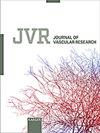血管周围脂肪组织对雌性SHRSP.Z-Leprf/IzmDmcr大鼠肠系膜上动脉内皮功能障碍的补偿
IF 1.8
4区 医学
Q3 PERIPHERAL VASCULAR DISEASE
引用次数: 1
摘要
血管周围脂肪组织(PVAT)对动脉张力的调节因性别而异。在雄性SHRSP中。Z-Leprfa/IzmDmcr大鼠(SHRSP.ZF),PVAT对发生在代谢综合征早期的内皮介导的血管舒张的损失具有补偿性舒张作用。然而,这种影响在23周大时会恶化。因此,在这里,我们比较了PVAT对雌性和雄性SHRSP的影响。ZF。23周龄的女性和男性在没有PVAT的情况下,乙酰胆碱诱导的肠系膜上动脉舒张没有差异。然而,PVAT的存在增强了23周龄女性的放松,但男性没有。PVAT中血管紧张素II 1型受体(AT1R)的mRNA水平在性别之间没有差异,但女性的AT1R相关蛋白(ATRAP)和apelin水平高于男性。我们观察到有和没有PVAT的动脉舒张差异与ATRAP或apelin mRNA水平之间存在正相关。与23周龄女性相比,30周龄女性PVAT增强的松弛消失,AT1R的mRNA水平增加,而apelin水平下降。这些结果表明,在SHRSP中。ZF、PVAT对内皮功能障碍的补偿在女性中延伸到比男性更大的年龄。Apelin和AT1R/ATRAP在PVAT中的表达可能是有利效果的预测因素。本文章由计算机程序翻译,如有差异,请以英文原文为准。
Perivascular Adipose Tissue Compensation for Endothelial Dysfunction in the Superior Mesenteric Artery of Female SHRSP.Z-Leprfa/IzmDmcr Rats
Regulation of arterial tone by perivascular adipose tissue (PVAT) differs between sexes. In male SHRSP.Z-Leprfa/IzmDmcr rats (SHRSP.ZF), PVAT exerts a compensatory relaxation effect for the loss of endothelium-mediated vasorelaxation, which occurs during the early stages of metabolic syndrome. However, this effect deteriorates by 23 weeks of age. Here, therefore, we compared the effects of PVAT in female and male SHRSP.ZF. Acetylcholine-induced relaxation in superior mesenteric artery without PVAT did not differ between 23-week-old females and males. However, the presence of PVAT enhanced relaxation in 23-week-old females, but not in males. The mRNA levels of angiotensin II type 1 receptor (AT1R) in PVAT did not differ between sexes, but AT1R-associated protein (ATRAP) and apelin levels were higher in females than in males. We observed a positive relationship between differences in artery relaxation with and without PVAT and ATRAP or apelin mRNA levels. In 30-week-old females, PVAT-enhanced relaxation disappeared, and mRNA levels of AT1R increased, while apelin levels decreased compared to 23-week-old females. These results demonstrated that in SHRSP.ZF, PVAT compensation for endothelium dysfunction extended to older ages in females than in males. Apelin and AT1R/ATRAP expression in PVAT may be predictors of favorable effects.
求助全文
通过发布文献求助,成功后即可免费获取论文全文。
去求助
来源期刊

Journal of Vascular Research
医学-生理学
CiteScore
3.40
自引率
0.00%
发文量
25
审稿时长
>12 weeks
期刊介绍:
The ''Journal of Vascular Research'' publishes original articles and reviews of scientific excellence in vascular and microvascular biology, physiology and pathophysiology. The scope of the journal covers a broad spectrum of vascular and lymphatic research, including vascular structure, vascular function, haemodynamics, mechanics, cell signalling, intercellular communication, growth and differentiation. JVR''s ''Vascular Update'' series regularly presents state-of-the-art reviews on hot topics in vascular biology. Manuscript processing times are, consistent with stringent review, kept as short as possible due to electronic submission. All articles are published online first, ensuring rapid publication. The ''Journal of Vascular Research'' is the official journal of the European Society for Microcirculation. A biennial prize is awarded to the authors of the best paper published in the journal over the previous two years, thus encouraging young scientists working in the exciting field of vascular biology to publish their findings.
 求助内容:
求助内容: 应助结果提醒方式:
应助结果提醒方式:


